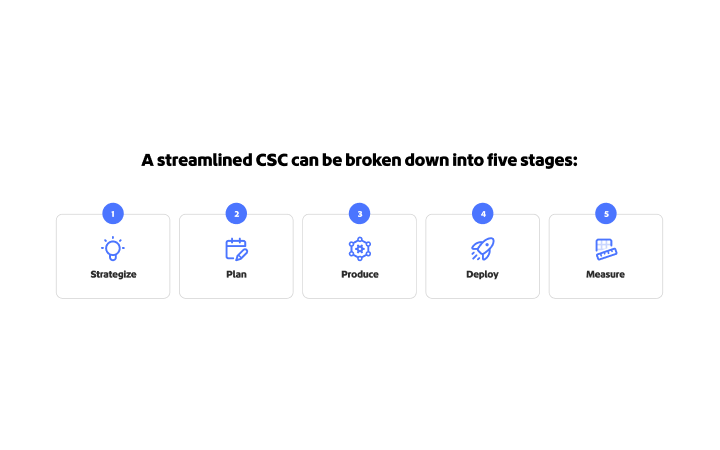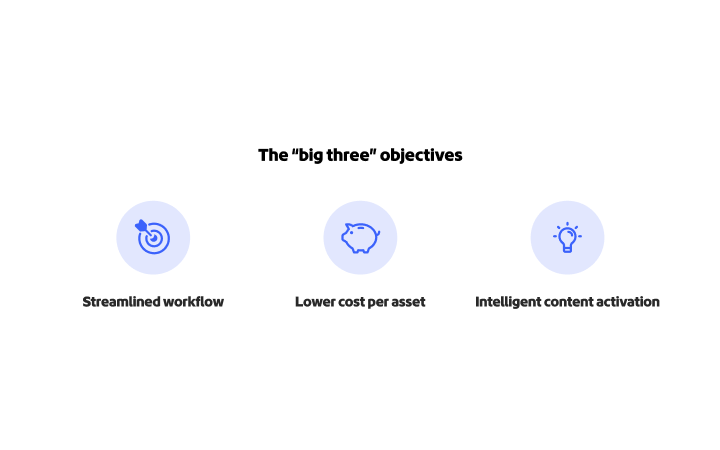Achieving your manufacturing goals with a connected content supply chain.
10-14-2025

The strategic importance of content for industrial manufacturers is still often underestimated. Yet, many of the same principles that define a tried-and-true manufacturing process — precision, efficiency, quality control, and streamlined workflows — also apply directly to content production.
Industrial manufacturers must support the complex products they create with high-quality, precise content. This includes detailed product images, intricate technical drawings, comprehensive spec sheets, immersive training material, interactive repair guides, and engaging solution case studies. As the demand for rich, personalized content continues to rise rapidly, businesses are urgently seeking ways to optimize their content production processes. This involves using AI-backed tools, advanced workflows, digital asset management (DAM) software, and deeply integrated collaboration systems. Without these advancements, a disorganized and inefficient content supply chain can create significant roadblocks for marketing, sales, and service teams, directly impacting customer satisfaction and market agility.
Keeping pace with customer demand for high-quality, relevant content remains a struggle for many. Manufacturers, in particular, deal with complex products that require extensive documentation and training — which must be updated instantly whenever products, components, or regulatory standards change.
This post will cover:
What is a content supply chain?
For industrial manufacturing businesses, a content supply chain refers to the end-to-end process encompassing creation, management, and strategic distribution of all content necessary to support the production of physical goods and fuel positive customer experiences. A highly streamlined content supply chain is a critical asset for industrial manufacturers because it ensures all stakeholders can access the precise information and documentation they need, exactly when they need it. This seamless flow supports the entire customer journey — from initial lead generation to long-term customer loyalty and repeat business.
To produce the highest quality content, businesses need battle-tested processes, unified data, and automated asset deployment. If content workflows are manual, fragmented across siloed tools and data sources, or require excessive manual intervention, it becomes impossible to compete effectively and meet the escalating expectations of customers. To navigate rapid product changes, frequent new launches, and dynamic supply chain challenges, industrial manufacturers require scalable tools and a reliable content supply chain built to handle immense and evolving demand.
Once content is created and approved, it's meticulously organized and distributed among relevant internal stakeholders — including engineers, designers, production teams, and suppliers. Following rigorous internal reviews and approvals, that content is then deployed externally to customers, channel partners, external agencies, and other key stakeholders.
The 5 stages of a streamlined content supply chain.
A well-orchestrated content supply chain effectively maps the entire journey of content — from initial internal intake and strategic planning, through creative production and iterative reviews, to final delivery to customers, ongoing relevance assessment, and continuous measurement of its impact.

Content supply chain for the industrial manufacturer.
Now that we’ve examined the foundational concept of a content supply chain, let’s take a closer look at its unique dynamics within the industrial manufacturing sector. Manufacturers often operate multiple plants, mills, or factories across diverse regions, serving a complex range of buyer groups or individual clients. This necessitates communicating precise regulations, product information, and detailed specifications tailored to each unique audience and geographical context.
Additionally, industrial manufacturers typically deal with highly complex products that demand exceptionally in-depth content. For instance, heavy equipment might feature numerous aftermarket parts whose specifications can frequently change due to supply chain dynamics, cost optimization efforts, or engineering updates. Similarly, industries like milling, mining, or chemicals often produce goods with intricate attributes that require constant updates to imagery, documentation, and compliance information. Managing these extensive content needs becomes a monumental challenge without scalable, integrated tools.
Here are just some of the ways industrial manufacturers leverage a robust content supply chain to communicate with customers and stakeholders:
- Comprehensive product images and catalogs
- Detailed product information and spec sheets
- Precise technical drawings or exploded view images for complex machines
- Step-by-step instructional guides and installation manuals
- Accessible technical support documentation
- Clear transportation and handling instructions
- In-depth training materials and online courses
- Compelling case studies and application stories
These examples scratch the surface of how manufacturers utilize content to inform, educate, and engage their diverse customer base. Ultimately, content supply chain encompasses virtually any piece of content a customer interacts with throughout their entire journey.
The “big three” objectives for your content supply chain.
To truly elevate their content supply chain, industrial manufacturers should focus on three critical objectives — streamlined workflow, lower cost per asset, and intelligent content activation.

Streamlined workflow.
- Eliminate manual bottlenecks: Disconnected, manual workflows are a primary cause of delays, errors, and inefficiencies in content production.
- Bridge silos: Disjointed communications and siloed operations prevent teams — like marketing, engineering, sales, and legal — from collaborating effectively, leading to duplicated efforts and misaligned objectives.
- Remove technology roadblocks: Outdated systems or fragmented tools for sharing and activating assets significantly slow down content creation and distribution, directly impacting productivity.
- Integrate feedback loops: Implementing real-time feedback mechanisms directly within creative tools enables teams to make necessary changes more quickly and accurately.
- Use AI for efficiency: AI-powered workflows transform content operations, enabling teams to quickly find and retrieve existing assets for enhanced searchability and maximize content reuse. Generative AI can even assist in drafting initial content versions or adapting existing content for new formats.
Lower cost per asset.
- Automate repetitive tasks: Eliminate the manual effort required for resizing, localizing, and versioning content, saving significant time and resources.
- Reduce errors: By automating these processes, manufacturers can drastically reduce the risk of manual errors and costly duplicative efforts.
- Accelerate production cycles: Faster content production helps meet demanding delivery times, keeps products competitive, and supports agile market entry.
- Enhance asset discoverability: Advanced asset search capabilities — powered by AI tagging and metadata — eliminate wasted time searching for existing assets to refresh or prevent the unnecessary creation of new assets when suitable options already exist.
Intelligent content activation.
- Data-driven distribution: Using real-time data and AI-powered insights enables manufacturers to target content across the most relevant channels and in the most impactful formats, ensuring maximum reach and relevance.
- Personalized engagement: By understanding how customers engage with content, marketing and sales teams can curate hyper-personalized messages and experiences that truly resonate with various buyer personas, driving deeper connections.
- Predictive optimization: Analyzing data on project timelines, content performance, and identifying potential bottlenecks enables manufacturers to take proactive action — ensuring projects are delivered on time and content performs optimally. This also includes leveraging AI to predict which content will perform best for specific audiences.
Streamline your content supply chain to give customers what they’re looking for.
A content supply chain ensures that each customer receives exactly what they need to solve their problems or meet their needs. While the manufacturing process creates the product you’re selling, a well-oiled content supply chain provides critical information and documentation that your customers need, precisely when they need it. Streamlining your content process can significantly improve efficiency, reduce errors, and enhance the overall quality and support for your products.
Elevating your content supply chain helps impress your B2B buyers by delivering seamless, integrated experiences across marketing, sales, and product support. When it’s easier for customers to find information, learn, and do business with you, you’ll not only drive significant cost savings but also achieve highly profitable, experience-led revenue growth.
Adobe Experience Cloud is the robust foundation you need to build and run a well-oiled content machine. With unified data, AI-powered insights — including generative AI capabilities — and advanced content automation, you can scale your marketing and sales efforts by transforming customer journeys into data-driven assisted and self-service experiences.
Learn more about Adobe’s solutions for the manufacturing industry.
Recommended for you
https://business.adobe.com/fragments/resources/cards/thank-you-collections/content-supply-chain
